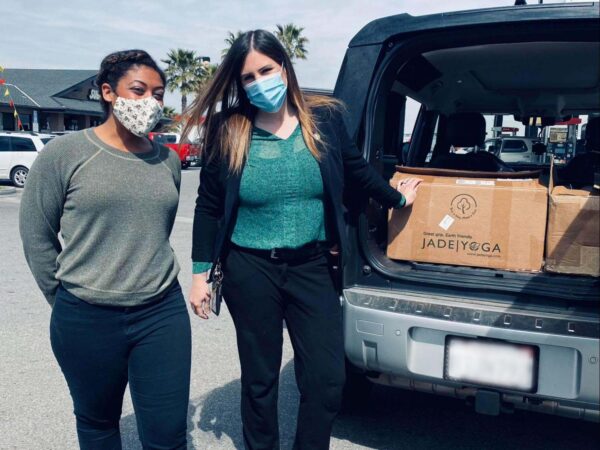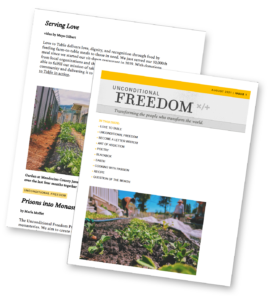By Marissa Ward
We sit at the smooth, white round table; Tanya, Marla, our group sponsor on the facility’s staff, and me. This is our first visit to Central California Women’s Facility — the prison in Chowchilla, California. There’s a moment of silence, and I notice the love and gratitude welling up inside of me. I try not to cry, an old habit that I’m starting to outgrow. With every letter I receive and every response I write, I practice letting emotion move through me.
We break the ice by handing Tanya her Art of Soulmaking Certificate of Completion. She looks down and smiles, beaming with warmth and appreciation. The conversation flows from there. Tanya has been leading a Soulmaking Community group, where graduates of the program can apply to become facilitators and lead their own groups on the inside about practices and topics from the workbook. She walks us through the group’s first two sessions. They’ve covered yoga and meditation so far, and the group members are starting to get more vulnerable with one another as time goes on.
We hear the five last names boom over the loudspeaker, and the officer calling them has a firm and kind tone to his voice. Within seconds, the five women are surrounding us at the round table. We do our introductions and they are open to us, ready to share about their practices. One of them asks for balancing poses, another asks for core strengthening exercises to help ease the tension from scar tissue, and another shares about her knee injury. Marla jots down notes. We ask the women how the group has been for them so far, and they share that connecting with others about the material from the course has them understand it even more. One woman shares about struggling with meditation for months because they are in a noisy environment with no privacy and in cells that they share with four to eight other women. Her first time really experiencing meditation is when she did it with her Soulmaking Community group, using the DVD from our Monastic Library and having the containment of the recreation room they use every Saturday morning.
During our tour of the housing unit, Tanya pulls out beautiful quilts and blankets, all sewn or crocheted by incarcerated women who then donate them to people in need. This month, all of their creations go towards suicide prevention month and the various centers and shelters. I watch her emanate the joy she feels from contributing, giving back to her community both within the walls and in the world outside of them. In that moment, I note the beauty of a woman seated in her purpose.
We arrive a little late, due to a complication with me and the metal detector. Where the women could have met us with shame or upset, they chose to offer warmth and empathy instead. I felt welcomed.
The recreation room only has enough space for their yoga mats and Marla’s. I sit on a folded up foam pad by the window to meditate for the first half of their class. I see what they mean about the noise; there is constant chatter in the common space right outside the door. One woman started a personal yoga practice during the 11 years she spent in solitary confinement at county jail. She taught herself yoga, and this was her first structured yoga class with a teacher in a very long time.
After the class, I ask the women what they noticed. One woman shared that she’s been stressed about her parole board hearing, and she felt the stress clear out for the first time in months during the yoga class. She acknowledged that she needs to make more time for yoga and practices in her life if she wants more access to that feeling. Tanya shared that she has a hard time relaxing because she’s always on alert and ready to help anyone in need, and this yoga class was the first time she could feel all of her body let go and unwind. Another woman said she forgot she was in prison.
Together we can see the value of practice. We start by talking about their writing with the Soul Letter exercises, a series of writing prompts that can be used to explore our inner world. Four of the women raise their hands to say they had written at least one Soul Letter. One woman shared how she had a lot of resistance to the desire Soul Letter exercise until she spoke with a friend in the program and was able to reframe desire as something she wants within herself. Another woman said she struggles with making the time for herself to practice and tend to her ‘acre of land,’ an analogy from the workbook about the soul being our acre to nurture and grow in this life. I asked them to pair off for partner exercises. We offer a prompt and then the women share about it with one another in groups of two.
“What’s something you love about yourself?”
“How much I care and how loving my heart is.”
“Thank you.”
“What’s something you love about yourself?”
“My ability to be with others in challenging situations.”
“Thank you.”
“What’s something you love about yourself?”
On and on until the timer runs out, and we switch directions so the other woman can share.
I could feel the people in the room settle during the third prompt, “This is what my soul wants to say.” Everything got quieter and a softness billowed outward, with at least one woman in each pair of two crying. Then the fourth prompt, “Who are you?” cracked through any final threads of the women holding back. The room was full and glowing with a feeling of honesty, the kind that comes when we reveal ourselves below the masks we wear daily to protect ourselves. I watched these women turn from hard to soft. We got to see new parts of one another.
The heart-opening feeling stayed with us into our final exercise for the day, The Loving Tree. We read the story about the Himba Tribe, how in times of difficulty or celebration, members of the village sing that individual’s unique song back at them to celebrate the essence of who they are. We circled up and one by one, each woman received reflections from the rest of the group to create their song; a song that they can always return to when they need a reminder of who they are. There were two women who have known each other for a long time and served in the county jail together too. It sounded like they had a tumultuous relationship over the years and this was a moment to acknowledge the deep love they have for one another, and how they see each other as a whole human. More tears released as we created each woman’s Loving Tree. I continued to watch these women soften as they shared the impact they’ve had on each other’s lives. There was a feeling of being seen and admired and loved for exactly who they are.

 Get access to the monthly Rehumanization Magazine featuring contributors from the front lines of this effort—those living on Death Row, residents of the largest women’s prison in the world, renowned ecologists, the food insecure, and veteran correctional officers alike.
Get access to the monthly Rehumanization Magazine featuring contributors from the front lines of this effort—those living on Death Row, residents of the largest women’s prison in the world, renowned ecologists, the food insecure, and veteran correctional officers alike.